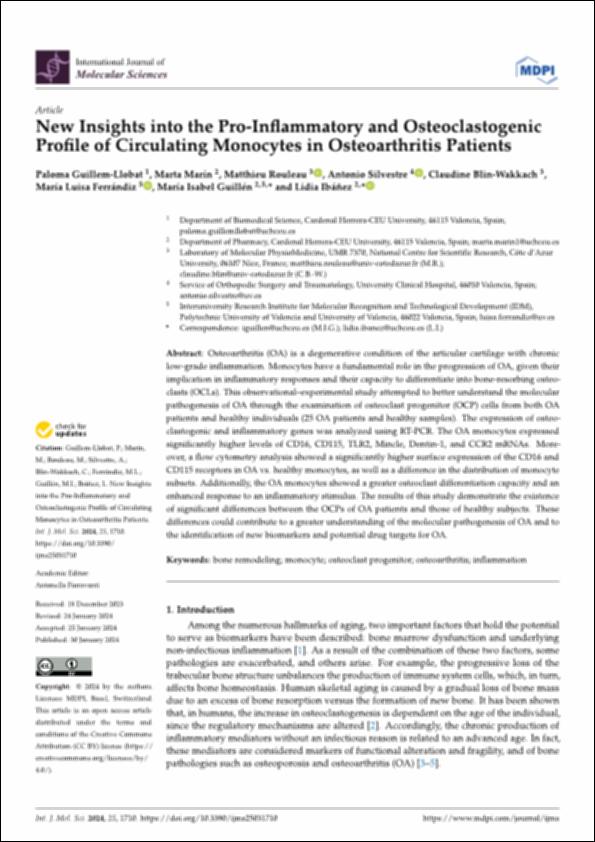Please use this identifier to cite or link to this item:
http://hdl.handle.net/10637/15337New Insights into the pro-inflammatory and osteoclastogenic profile of circulating monocytes in osteoarthritis patients
| Title: | New Insights into the pro-inflammatory and osteoclastogenic profile of circulating monocytes in osteoarthritis patients |
| Authors : | Guillem Llobat, Paloma Marín Vázquez, Marta Rouleau, Matthieu Silvestre, Antonio Blin-Wakkach, Claudine Ferrándiz, María Luisa Guillén Salazar, María Isabel Ibáñez Torres, Lidia |
| Keywords: | Osteoartritis; Osteoarthritis; Inflamación; Inflammation; Cartílagos; Cartilage; Célula; Cells |
| Publisher: | MDPI |
| Citation: | Guillem-Llobat, P., Marín, M., Rouleau, M., Silvestre, A., Blin-Wakkach, C., Ferrándiz, M.L., Guillén, M.I. & Ibáñez, L. (2024). New Insights into the pro-inflammatory and osteoclastogenic profile of circulating monocytes in osteoarthritis patients. International Journal of Molecular Sciences, vol. 25, i. 3, art. 1710 (30 jan.). DOI: https://doi.org/10.3390/ijms25031710 |
| Abstract: | Osteoarthritis (OA) is a degenerative condition of the articular cartilage with chronic low-grade inflammation. Monocytes have a fundamental role in the progression of OA, given their implication in inflammatory responses and their capacity to differentiate into bone-resorbing osteoclasts (OCLs). This observational–experimental study attempted to better understand the molecular pathogenesis of OA through the examination of osteoclast progenitor (OCP) cells from both OA patients and healthy individuals (25 OA patients and healthy samples). The expression of osteoclastogenic and inflammatory genes was analyzed using RT-PCR. The OA monocytes expressed significantly higher levels of CD16, CD115, TLR2, Mincle, Dentin-1, and CCR2 mRNAs. Moreover, a flow cytometry analysis showed a significantly higher surface expression of the CD16 and CD115 receptors in OA vs. healthy monocytes, as well as a difference in the distribution of monocyte subsets. Additionally, the OA monocytes showed a greater osteoclast differentiation capacity and an enhanced response to an inflammatory stimulus. The results of this study demonstrate the existence of significant differences between the OCPs of OA patients and those of healthy subjects. These differences could contribute to a greater understanding of the molecular pathogenesis of OA and to the identification of new biomarkers and potential drug targets for OA. |
| URI: | http://hdl.handle.net/10637/15337 |
| Rights : | Open Access http://creativecommons.org/licenses/by/4.0/deed.es |
| ISSN: | 1422-0067 (Electrónico) |
| Issue Date: | 30-Jan-2024 |
| Center : | Universidad Cardenal Herrera-CEU |
| Appears in Collections: | Dpto. Farmacia |
Items in DSpace are protected by copyright, with all rights reserved, unless otherwise indicated.


